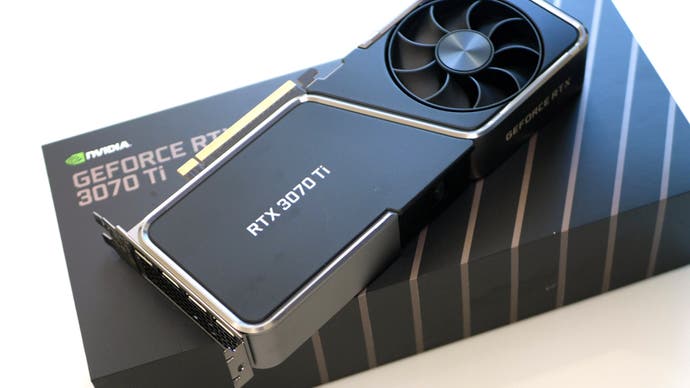Nvidia GeForce RTX 3070 Ti review: Resizable BAR
What you need to access the feature - and what you get in return.
So: Resizable BAR. We've covered this tech before, but the gist of it is that by allowing your processor direct access to all graphics card memory, rather than only the traditional 256MB I/O buffer, you can speed up game frame-rates by up to double-digit amounts. Not all games will benefit, but Nvidia graphics cards will only use the feature in games that the company has whitelisted.

To actually use Resizable BAR, you'll need to have a motherboard running a BIOS with the feature, a supported CPU, a recent Nvidia driver and a recent version of Windows 10. Once you've ensured you meet the lengthy requirements, you'll need to head into your motherboard's BIOS and enable the feature. On our Asus system, that means enabling 'Above 4G Decoding' in the PCI Subsystem Settings, which in turn allows you to enable 'Re-Size BAR Support'. (Note that enabling SAM in your BIOS also disables CSM, a feature that allows non-UEFI installations of Windows 10 to boot, so you may need to reinstall Windows or convert your boot drive from MBR to GPT if your current installation uses the older MBR standard.)
Pro tip: You may find it helpful to install GPU-Z 2.40.00 or later, as the tool now includes a special Resizable BAR window that shows whether the feature is active and, if not, which requirements you're not currently fulfilling. To see this, just click on the Resizable BAR readout on the main screen of the application or navigate to the Advanced tab then select PCIe Resizable BAR from the dropdown at the top.
We tested each game at multiple resolutions with Resizable BAR enabled and disabled, using the same 10900K test system as you've seen in the rest of this review.
Borderlands 3
Borderlands 3 comes first, and just like in our RTX 3080 Ti testing, we see only small performance advantages (normally around two percent) by enabling Resizable BAR - plus some rather worrying stutters in the integrated benchmark. We're not sure what's going on here, as we didn't face this problem when testing earlier RTX cards, but it may be a driver issue that gets fixed down the road. In any case, it may be worth testing yourself using a static scene and a readout of your worst one percent scores to see if enabling ReBAR is worth it if Borderlands 3 is your go-to game.
Borderlands 3: Bad Ass, DX12, TAA
Control
Control comes next, and here we see a different but also baffling result - performance regressions with ReBAR enabled. It's not a huge drop but to see performance drop at all is strange. This is the sort of thing that whitelisting should prevent, so we're not sure what's happened here - but assuming our result is representative of ReBar performance across the board, we can't recommend it for this title.
Control: High, DX12, TAA
Death Stranding
Death Stranding is one of the funniest benchmarks we have, as Mr Bridges runs through the wilderness, occasionally stumbling over a rock and coming down like a pile of bricks. Again, there are only modest performance enhancements we see here, which hover around four percent at each resolution we tested without the stutters we observed in Borderlands 3 - a small but palpable win on our test system.
Death Stranding: Max, DX12, TAA
Assassin's Creed Valhalla
Assassin's Creed Valhalla shows us how to count, as we get four, five, six percentage point gains from enabling ReBAR. As with the earlier titles we tested, this isn't enough to shift the game's performance profile drastically, but it's still a measurable boost - so no complaints here.
AC Valhalla: DX12, Ultra, TAA
Our final range of tests looks at ray tracing, where the RTX 3080 Ti did slightly better compared to its vanilla counterpart than we saw in other tests - will we get a similar result from the 3070 Ti? Let's take a look.
Nvidia GeForce RTX 3070 Ti analysis
- Introduction and hardware analysis
- Doom Eternal, Control, Borderlands 3, Shadow of the Tomb Raider - Game Benchmarks Part 1
- Death Stranding, Far Cry 5, Hitman 2, Assassin's Creed Odyssey - Game Benchmarks Part 2
- Metro Exodus, Dirt Rally 2, Assassin's Creed Unity - Game Benchmarks Part 3
- Resizable BAR benchmarks and requirements [This Page]
- Control, Metro Exodus, Battlefield 5 - RT game benchmarks
- Nvidia GeForce RTX 3070 Ti - the Digital Foundry verdict








